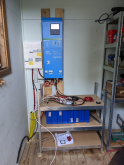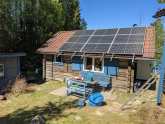First of all, this forum is amazing and I've spent almost every free moment I've had over the last weeks to absorb as much knowledge as possible. I was leaning towards posting this in the Beginners Corner - please move it if that's where this belongs!
I still feel I might be in a bit over my head and need help with how to properly build an offgrid system for a small cabin in northern Sweden. I will be getting professional help from a friend who is an electrician but he's not overly familiar with offgrid systems.
What it will power
Mostly lights and a fridge, but also occasionally some appliances such as coffee machine and power tools. I also want to run a 4G router at all times (which will be used so I can monitor the system through the Victron Remote Management portal), but I don't want to power it through the inverter and suffer the 25w idle consumption when I'm not there.
My setup

Questions
I still feel I might be in a bit over my head and need help with how to properly build an offgrid system for a small cabin in northern Sweden. I will be getting professional help from a friend who is an electrician but he's not overly familiar with offgrid systems.
What it will power
Mostly lights and a fridge, but also occasionally some appliances such as coffee machine and power tools. I also want to run a 4G router at all times (which will be used so I can monitor the system through the Victron Remote Management portal), but I don't want to power it through the inverter and suffer the 25w idle consumption when I'm not there.
My setup

- Main unit: Victron Easysolar EasySolar 48/3000/35-50 with MPPT150/70
- Battery: 16x 280ah Lifepo4 cells from Xuba (as discussed in the DIY Lifepo4 section) and a Daly 200A 48v/16s BMS. Battery wire: AWG 5 (16mm2) with 63A Mini Circuit Breaker (SCHNEIDER ELECTRIC iC60N 1P C63A "Type C").
- Solarpanels: 9x Astronergy CHSM6612P 325W (max 45.67 V / 9.48 A) wired 3 in series, 3 in parallel with each series connected to 10A circuit breaker (Siemens 5SY5110-6). 6 placed on custom ground mount facing south and have no shading, 3 on roof that will be facing east and partly shaded by trees after noon. Since the MPPT allow max 30A connected to either of the two MC4 pairs, I intend to connect 2x3 to one pair and 1x3 to the second which allows me to expand with an additional 3 ground mounted should it be required in the future. All wires is AWG 9 (6mm2) and the wires will be combined after the circuit breakers to the MPPT.
- Router: Teltonika RUT950 that will be powered through POE using Alfa 48VDC to 24V PoE Adapter (0.7A max) with a 1A circuit breaker (SCHNEIDER ELECTRIC iC60N 1P C1A). The Victron Multiplus inside the Easysolar has a programmable relay (max 1A) that I intend to set to either SOC or low voltage disconnect and wire a 16 AWG positive (?) wire from the through the relay.
Questions
- Does this look alright?
- Does a 63A circuit breaker type C make sense to the battery? I've understood Type C can handle temporarily higher loads.
- I have AWG 5 (16mm2) wires and don't really want to buy larger unless I have to. Do I?
- Does the programmable relay setup with the router make sense?





